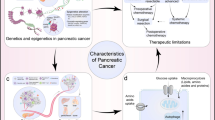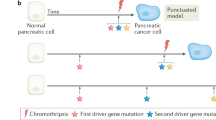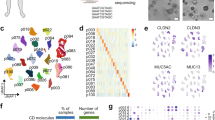Abstract
Pancreatic ductal adenocarcinoma (PDA) is a lethal disease. Overall survival is typically 6 months from diagnosis1. Numerous phase 3 trials of agents effective in other malignancies have failed to benefit unselected PDA populations, although patients do occasionally respond. Studies in other solid tumors have shown that heterogeneity in response is determined, in part, by molecular differences between tumors. Furthermore, treatment outcomes are improved by targeting drugs to tumor subtypes in which they are selectively effective, with breast2 and lung3 cancers providing recent examples. Identification of PDA molecular subtypes has been frustrated by a paucity of tumor specimens available for study. We have overcome this problem by combined analysis of transcriptional profiles of primary PDA samples from several studies, along with human and mouse PDA cell lines. We define three PDA subtypes: classical, quasimesenchymal and exocrine-like, and we present evidence for clinical outcome and therapeutic response differences between them. We further define gene signatures for these subtypes that may have utility in stratifying patients for treatment and present preclinical model systems that may be used to identify new subtype specific therapies.
This is a preview of subscription content, access via your institution
Access options
Subscribe to this journal
Receive 12 print issues and online access
$209.00 per year
only $17.42 per issue
Buy this article
- Purchase on Springer Link
- Instant access to full article PDF
Prices may be subject to local taxes which are calculated during checkout




Similar content being viewed by others
Accession codes
References
Stathis, A. & Moore, M.J. Advanced pancreatic carcinoma: current treatment and future challenges. Nat. Rev. Clin. Oncol. 7, 163–172 (2010).
Slamon, D.J. et al. Use of chemotherapy plus a monoclonal antibody against HER2 for metastatic breast cancer that overexpresses HER2. N. Engl. J. Med. 344, 783–792 (2001).
Lynch, T.J. et al. Activating mutations in the epidermal growth factor receptor underlying responsiveness of non–small-cell lung cancer to gefitinib. N. Engl. J. Med. 350, 2129–2139 (2004).
Alizadeh, A.A. et al. Distinct types of diffuse large B-cell lymphoma identified by gene expression profiling. Nature 403, 503–511 (2000).
Badea, L., Herlea, V., Dima, S.O., Dumitrascu, T. & Popescu, I. Combined gene expression analysis of whole-tissue and microdissected pancreatic ductal adenocarcinoma identifies genes specifically overexpressed in tumor epithelia. Hepatogastroenterology 55, 2016–2027 (2008).
Herschkowitz, J.I. et al. Identification of conserved gene expression features between murine mammary carcinoma models and human breast tumors. Genome Biol. 8, R76 (2007).
Benito, M. et al. Adjustment of systematic microarray data biases. Bioinformatics 20, 105–114 (2004).
Brunet, J.P., Tamayo, P., Golub, T.R. & Mesirov, J.P. Metagenes and molecular pattern discovery using matrix factorization. Proc. Natl. Acad. Sci. USA 101, 4164–4169 (2004).
Tusher, V.G., Tibshirani, R. & Chu, G. Significance analysis of microarrays applied to the ionizing radiation response. Proc. Natl. Acad. Sci. USA 98, 5116–5121 (2001).
Balagurunathan, Y. et al. Gene expression profiling–based identification of cell-surface targets for developing multimeric ligands in pancreatic cancer. Mol. Cancer Ther. 7, 3071–3080 (2008).
Pei, H. et al. FKBP51 affects cancer cell response to chemotherapy by negatively regulating Akt. Cancer Cell 16, 259–266 (2009).
Grützmann, R. et al. Gene expression profiling of microdissected pancreatic ductal carcinomas using high-density DNA microarrays. Neoplasia 6, 611–622 (2004).
Brennan, M.F., Kattan, M.W., Klimstra, D. & Conlon, K. Prognostic nomogram for patients undergoing resection for adenocarcinoma of the pancreas. Ann. Surg. 240, 293–298 (2004).
Biankin, A.V. et al. Expression of S100A2 calcium-binding protein predicts response to pancreatectomy for pancreatic cancer. Gastroenterology 137, 558–568 (2009).
Blackford, A. et al. SMAD4 gene mutations are associated with poor prognosis in pancreatic cancer. Clin. Cancer Res. 15, 4674–4679 (2009).
Bardeesy, N. et al. Both p16(Ink4a) and the p19(Arf)-p53 pathway constrain progression of pancreatic adenocarcinoma in the mouse. Proc. Natl. Acad. Sci. USA 103, 5947–5952 (2006).
Kouros-Mehr, H., Slorach, E.M., Sternlicht, M.D. & Werb, Z. GATA-3 maintains the differentiation of the luminal cell fate in the mammary gland. Cell 127, 1041–1055 (2006).
Mehra, R. et al. Identification of GATA3 as a breast cancer prognostic marker by global gene expression meta-analysis. Cancer Res. 65, 11259–11264 (2005).
Decker, K., Goldman, D.C., Grasch, C.L. & Sussel, L. Gata6 is an important regulator of mouse pancreas development. Dev. Biol. 298, 415–429 (2006).
Kwei, K.A. et al. Genomic profiling identifies GATA6 as a candidate oncogene amplified in pancreatobiliary cancer. PLoS Genet. 4, e1000081 (2008).
Fu, B., Luo, M., Lakkur, S., Lucito, R. & Iacobuzio-Donahue, C.A. Frequent genomic copy number gain and overexpression of GATA-6 in pancreatic carcinoma. Cancer Biol. Ther. 7, 1593–1601 (2008).
Gidekel Friedlander, S.Y. et al. Context-dependent transformation of adult pancreatic cells by oncogenic K-Ras. Cancer Cell 16, 379–389 (2009).
Singh, A. et al. A gene expression signature associated with “K-Ras addiction” reveals regulators of EMT and tumor cell survival. Cancer Cell 15, 489–500 (2009).
Moore, M.J. et al. Erlotinib plus gemcitabine compared with gemcitabine alone in patients with advanced pancreatic cancer: a phase III trial of the National Cancer Institute of Canada Clinical Trials Group. J. Clin. Oncol. 25, 1960–1966 (2007).
Yauch, R.L. et al. Epithelial versus mesenchymal phenotype determines in vitro sensitivity and predicts clinical activity of erlotinib in lung cancer patients. Clin. Cancer Res. 11, 8686–8698 (2005).
De Roock, W. et al. Association of KRAS p.G13D mutation with outcome in patients with chemotherapy-refractory metastatic colorectal cancer treated with cetuximab. J. Am. Med. Assoc. 304, 1812–1820 (2010).
International Cancer Genome Consortium. International network of cancer genome projects. Nature 464, 993–998 (2010).
Raut, C.P., Evans, D.B., Crane, C.H., Pisters, P.W. & Wolff, R.A. Neoadjuvant therapy for resectable pancreatic cancer. Surg. Oncol. Clin. N. Am. 13, 639–661, ix (2004).
McDermott, U. et al. Identification of genotype-correlated sensitivity to selective kinase inhibitors by using high-throughput tumor cell line profiling. Proc. Natl. Acad. Sci. USA 104, 19936–19941 (2007).
Kuehn, H., Liberzon, A., Reich, M. & Mesirov, J.P. Using GenePattern for gene expression analysis. Curr. Protoc. Bioinformatics 22, 7.12.1–7.12.39 (2008).
Gentleman, R.C. et al. Bioconductor: open software development for computational biology and bioinformatics. Genome Biol. 5, R80 (2004).
Eisen, M.B., Spellman, P.T., Brown, P.O. & Botstein, D. Cluster analysis and display of genome-wide expression patterns. Proc. Natl. Acad. Sci. USA 95, 14863–14868 (1998).
Yagoda, N. et al. RAS-RAF-MEK-dependent oxidative cell death involving voltage-dependent anion channels. Nature 447, 864–868 (2007).
Kanematsu, A., Ramachandran, A. & Adam, R.M. GATA-6 mediates human bladder smooth muscle differentiation: involvement of a novel enhancer element in regulating alpha-smooth muscle actin gene expression. Am. J. Physiol. Cell Physiol. 293, C1093–C1102 (2007).
Collisson, E.A., De, A., Suzuki, H., Gambhir, S.S. & Kolodney, M.S. Treatment of metastatic melanoma with an orally available inhibitor of the Ras-Raf-MAPK cascade. Cancer Res. 63, 5669–5673 (2003).
Sadanandam, A., Collisson, E., Gibb, W., Hanahan, D. & Gray, J. Nature Protocols 10.1038/protex.2011.231 (2011).
Acknowledgements
We are grateful to M. Lenburg and the Gray, Hanahan and Speed labs for discussion. We thank L. Chin (Dana-Farber Cancer Institute) for 3.27, TU8988S, TU8988T, Tu8902, DanG and HupT3, S. Batra (University of Nebraska Medical Center) for Suit2, M. McMahon (UCSF) for HPAC, Capan2, HPAF II, 6.03, CFPac1, MPanc96, 2.13, Panc1, MiaPaca2, 10.05 and Colo357, and A. Singh (Massachusetts General Hospital) for Sw1990. B. Stockwell (New York University) kindly provided pLKOshKRAS 5. R. Adam (Children's Hospital Boston) kindly provided pLKOshGATA6 5. E.A.C. was supported by a Young Investigator Award from the American Society of Clinical Oncology and US National Cancer Institute (NCI) K08 CA137153. A.S. was supported by a US Department of Defense Postdoctoral Fellowship (BC087768). The research in the laboratory of D.H. was supported by an NCI Program Project Grant PO1 CA 117969; D.H. is an American Cancer Society Research Professor. This work was supported by the Director, Office of Science, Office of Biological & Environmental Research, of the United States Department of Energy under contract no. DE-AC02-05CH11231, and by NCI grants P50 CA 58207, P50 CA 83639 and U54 CA 112970 to J.W.G.
Author information
Authors and Affiliations
Contributions
E.A.C. and A.S. designed, conducted and interpreted experiments and wrote the manuscript. P.O., W.J.G., M.T., S.G., J.C., J.W., L.J., and H.S.F. performed experiments. K.L.D. and P.T.S. provided support and interpreted experiments. G.E.K. and A.H.K. coordinated clinical sample acquisition. A.B.O. provided statistical expertise. M.A.T. provided support, interpreted experiments and coordinated clinical sample acquisition. D.H. and J.W.G. designed and interpreted experiments, wrote the manuscript and supervised the project.
Corresponding author
Ethics declarations
Competing interests
J.C. and K.L.D. are employees of Response Genetics. P.O. is an employee of Pfizer. W.J.G. is an employee of Genomic Health.
Supplementary information
Supplementary Text and Figures
Supplementary Figures 1–7 and Supplementary Methods (PDF 2739 kb)
Supplementary Table 1
Variable and NMF genes for core clinical PDA microarray data sets (XLS 277 kb)
Supplementary Table 2
Patient identifiers and subtypes for different PDA microarray data sets (XLS 36 kb)
Supplementary Table 3
DWD combined matrix containing samples from UCSF and Badea et al., gene expression microarray datasets and 62 PDA assigner genes (XLS 105 kb)
Supplementary Table 4
Patient characteristics and statistical analysis (XLS 30 kb)
Supplementary Table 5
DWD combined matrix containing score clinical samples and human cell lines gene expression microarray datasets and 62 PDA assigner genes (XLS 110 kb)
Supplementary Table 6
DWD combined matrix containing score clinical samples and mouse cell lines gene expression microarray datasets and 62 PDA assigner genes (XLS 84 kb)
Rights and permissions
About this article
Cite this article
Collisson, E., Sadanandam, A., Olson, P. et al. Subtypes of pancreatic ductal adenocarcinoma and their differing responses to therapy. Nat Med 17, 500–503 (2011). https://doi.org/10.1038/nm.2344
Received:
Accepted:
Published:
Issue Date:
DOI: https://doi.org/10.1038/nm.2344
This article is cited by
-
Pancreatic cancer acquires resistance to MAPK pathway inhibition by clonal expansion and adaptive DNA hypermethylation
Clinical Epigenetics (2024)
-
Therapeutic developments in pancreatic cancer
Nature Reviews Gastroenterology & Hepatology (2024)
-
Epigenetic priming targets tumor heterogeneity to shift transcriptomic phenotype of pancreatic ductal adenocarcinoma towards a Vitamin D susceptible state
Cell Death & Disease (2024)
-
Deciphering cellular plasticity in pancreatic cancer for effective treatments
Cancer and Metastasis Reviews (2024)
-
Prospective observational study on biomarkers of response in pancreatic ductal adenocarcinoma
Nature Medicine (2024)



